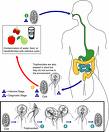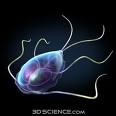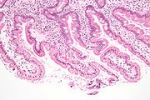September 1, 2009 tashlj

Flagellated Protozoan
Pathogen: G. lamblia
Category of Pathogen : Flagellated protozoan parasite
Name of the disease caused by the pathogen: Giardia                 Â
Symptoms of infection: The symptoms are diarrhea, gas or flatulence, greasy stools that float, abnormal stomach or abdominal cramps, upset stomach, and nausea
Primary host(s): Animals such as dogs, cats, and birds are very common host. Humans, especially children are common hosts as well.

Life cycle of Giardia
Other host(s): Other animals such as cows, beavers, and sheep are host of the infection.
Route of transmission: Transmission occurs through contaminated foods and water. It is also transmitted through oral anal sex with someone who is contaminated.
Ro: The rate of increase is about 16.29 out of 100,000 in Canada. In the United States it is about 1 in every 6,138 people.
Prevalence. The prevalence is about 2% in the United States and it is about 15-20% internationally. It has a higher prevalence in the tropic areas.
Generation time: The infection may last about 2-6 weeks. It can last longer.
Mortality Rate: There is no mortality rate associated with this infection. If mortality occurs it is because of dehydration or mal nourishment, which usually occurs in infected infants.
Morbidity Rate: The morbidity rate of the infection is very moderate and involves GI symptoms.Â
Is it preventable? How? Yes, it is preventable. 1. Practice good hygiene by washing body and hands. 2. Avoid contaminated water. 3. Avoid eating contaminated foods. 4. Avoid fecal exposure during sexual activity.
Does the disease trigger a long lasting immunity?: Yes, It has shown to have a long lasting immunity, which is why children get it more than adults. Once you have been infected it is harder to get it again.

Staining of Giardia
When was the pathogen first described and is there evidence that it was around much earlier than that?
 It was first observed in 1681 by Antonie van Leeuwenkoek in his own stools. No, there was no real evidence it was around much longer, but because of the time frame it was found it is possible it was.
What is the economic impact of the disease? In the case of animals if effects productivity. It does not tend to impact areas that are highly developed. It could affect water supply.
Medications used for the disease:
The medications used to treat Giardia for human infection are metronidazole, tinidazole, or nitazoxanide. These medications are not recommended for pregnant women. The alternative drug used to treat Giardia is berberine sulfate.
| Drug | Treatment duration | Possible Side Effects |
|---|---|---|
| Metronidazole | 5–7 days | Metallic taste; nausea; vomiting; dizziness; headache; disulfiram-like effect; neutropenia |
| Tinidazole | Single dose | Metallic taste; nausea; vomiting; belching; dizziness; headache; disulfiram-like effect |
| Nitazoxanide | 3 days | Abdominal pain; diarrhea; vomiting; headache; yellow-green discolouration of urine |
| Albendazole | 5 days | Dizziness; headache; fever; nausea; vomiting; temporary hair loss |
In animals like cats and lambs can recover easily from the disease, but the parasite is deadly for calves. Dogs can also be treated easily but the grasses they play in is considered contaminated for about a month and their kennels must remain clean.
The coolest thing about the disease: The coolest things I found about the disease is that even our everyday routines could not necessarily prevent us from getting infected. We may think that the water is not contaminated but can be, and the same with food. I have always said that children are the “nasty,†in the sense that they don’t know how to wash their hands good or they don’t like washing their hands at all. It is because of things like Giardiasis that we teach our kids to do so.
www.youtube.com/watch?v=bGMor71WkFc
Citations for the information included:
Giardia. Retrieved August 30, 2009, from http://www.water-research.net/giardia.1.htm
Prevalence and Incidence of Giardia. (2008). Retrieved August 30, 2009, from http://www.wrongdiagnosis.com/g/giardia/prevalence.htm
 Pennardt, A (2009, Apr 28). Giardiasis. emedicine. Retreived August 30,2009, from http://emedicine.medscape.com/article/782818-overview
Giardia Lamblia. Retreived August 30, 2009, from http://en.wikipedia.org/wiki/Giardia_lamblia
Entry Filed under: Uncategorized
Trackback this post  | Subscribe to comments via RSS Feed

没有评论:
发表评论